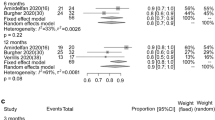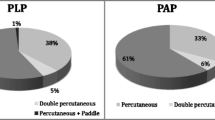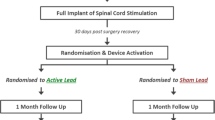Abstract
Purpose
Intractable upper limb and neck pain has traditionally been a challenging pain condition to treat, with conventional spinal cord stimulation (SCS) often inducing positional variation in paraesthesia and/or inadequate coverage of axial neck pain. The purpose of this Australian multi-centre prospective, clinical trial was to assess the safety and effectiveness of paraesthesia-independent 10 kHz SCS for the treatment of upper limb and neck pain.
Methods
Subjects with chronic, intractable neck and/or upper limb pain of ≥ 5 cm (on a 0–10-cm visual analogue scale) were enrolled (ACTRN12614000153617) following human research ethics committee approval. Subjects were implanted with two epidural leads spanning C2–C6 vertebral bodies. Subjects with successful trial stimulation were implanted with a Senza® system (Nevro Corp., Redwood City, CA, USA) and included in the safety and effectiveness evaluation at 3 months post-implant (primary endpoint assessment, PEA) and followed to 12 months.
Results
Overall, 31/38 (82.6%) subjects reported a successful 10 kHz SCS trial and proceeded to a permanent implant. Twenty-three of 30 subjects (76.7%) met the PEA. Subjects reported a reduction in neck pain and upper limb pain from baseline at the PEA (8.1 ± 0.2 cm vs. 2.9 ± 0.5 cm, 7.3 ± 0.3 cm vs. 2.5 ± 0.5 cm, respectively, p ≤ 0.0001). Disability, as measured by pain disability index score, decreased from 42.6 ± 2.6 at baseline to 22.7 ± 3.2 at PEA. Results were maintained 12 months post-implant. No neurological deficits, nor reports of paraesthesia, were observed.
Conclusions
Stable, long-term results demonstrated that 10 kHz SCS is a promising therapy option for intractable chronic upper limb and neck pain.





Similar content being viewed by others
References
Cohen SP (2015) Epidemiology, diagnosis, and treatment of neck pain. Mayo Clin Proc 90(2):284–299. https://doi.org/10.1016/j.mayocp.2014.09.008
Vallejo R, Kramer J, Benyamin R (2007) Neuromodulation of the cervical spinal cord in the treatment of chronic intractable neck and upper extremity pain: a case series and review of the literature. Pain Phys 10(2):305–311
Clarke MJ, Schiefer TK, Pichelmann MA, Krauss WE (2011) Axial neck pain: a surgeon’s perspective. Therapy 8(6):763–770
Provenzano DA, Amirdelfan K, Kapural L, Sitzman BT (2017) Evidence gaps in the use of spinal cord stimulation for treating chronic spine conditions. Spine 42(Suppl 14):S80–S92. https://doi.org/10.1097/brs.0000000000002184
Deer TR, Mekhail N, Provenzano D, Pope J, Krames E, Leong M, Levy RM, Abejon D, Buchser E, Burton A, Buvanendran A, Candido K, Caraway D, Cousins M, DeJongste M, Diwan S, Eldabe S, Gatzinsky K, Foreman RD, Hayek S, Kim P, Kinfe T, Kloth D, Kumar K, Rizvi S, Lad SP, Liem L, Linderoth B, Mackey S, McDowell G, McRoberts P, Poree L, Prager J, Raso L, Rauck R, Russo M, Simpson B, Slavin K, Staats P, Stanton-Hicks M, Verrills P, Wellington J, Williams K, North R, Neuromodulation Appropriateness Consensus C (2014) The appropriate use of neurostimulation of the spinal cord and peripheral nervous system for the treatment of chronic pain and ischemic diseases: the Neuromodulation Appropriateness Consensus Committee. Neuromodulation 17(6):515–550. https://doi.org/10.1111/ner.12208discussion 550
Haider N, Ligham D, Quave B, Harum KE, Garcia EA, Gilmore CA, Miller N, Moore GA, Bains A, Lechleiter K, Jain R (2018) Spinal cord stimulation (SCS) trial outcomes after conversion to a multiple waveform SCS system. Neuromodulation 21(5):504–507. https://doi.org/10.1111/ner.12783
Hunter CW, Carlson J, Yang A, Deer T (2018) Spinal cord stimulation for the treatment of failed neck surgery syndrome: outcome of a prospective case series. Neuromodulation 21(5):495–503. https://doi.org/10.1111/ner.12769
Salmon J (2019) High-frequency spinal cord stimulation at 10 kHz for widespread pain: a retrospective survey of outcomes from combined cervical and thoracic electrode placements. Postgrad Med 131(3):230–238. https://doi.org/10.1080/00325481.2019.1587564
Amirdelfan K, Vallejo R, Benyamin R, Yu C, Yang T, Bundschu R, Yearwood TL, Sitzman BT, Gliner B, Subbaroyan J, Rotte A, Caraway D (2019) High-frequency spinal cord stimulation at 10 kHz for the treatment of combined neck and arm pain: results from a prospective multicenter study. Neurosurgery. https://doi.org/10.1093/neuros/nyz495
Simpson BA, Bassett G, Davies K, Herbert C, Pierri M (2003) Cervical spinal cord stimulation for pain: a report on 41 patients. Neuromodulation 6(1):20–26. https://doi.org/10.1046/j.1525-1403.2003.03003.x
Jang HD, Kim MS, Chang CH, Kim SW, Kim OL, Kim SH (2008) Analysis of failed spinal cord stimulation trials in the treatment of intractable chronic pain. J Korean Neurosurg Soc 43(2):85–89. https://doi.org/10.3340/jkns.2008.43.2.85
Russo M, Van Buyten JP (2015) 10-kHz high-frequency SCS therapy: a clinical summary. Pain Med 16(5):934–942. https://doi.org/10.1111/pme.12617
Al-Kaisy A, Palmisani S, Smith T, Harris S, Pang D (2015) The use of 10-kilohertz spinal cord stimulation in a cohort of patients with chronic neuropathic limb pain refractory to medical management. Neuromodulation 18(1):18–23. https://doi.org/10.1111/ner.12237discussion 23
Kapural L, Yu C, Doust MW, Gliner BE, Vallejo R, Sitzman BT, Amirdelfan K, Morgan DM, Brown LL, Yearwood TL, Bundschu R, Burton AW, Yang T, Benyamin R, Burgher AH (2015) Novel 10-kHz high-frequency therapy (HF10 therapy) is superior to traditional low-frequency spinal cord stimulation for the treatment of chronic back and leg pain: the SENZA-RCT randomized controlled trial. Anesthesiology 123(4):851–860. https://doi.org/10.1097/ALN.0000000000000774
Amirdelfan K, Yu C, Doust MW, Gliner BE, Morgan DM, Kapural L, Vallejo R, Sitzman BT, Yearwood TL, Bundschu R, Yang T, Benyamin R, Burgher AH, Brooks ES, Powell AA, Subbaroyan J (2018) Long-term quality of life improvement for chronic intractable back and leg pain patients using spinal cord stimulation: 12-month results from the SENZA-RCT. Qual Life Res 27(8):2035–2044. https://doi.org/10.1007/s11136-018-1890-8
Tait RC, Chibnall JT, Krause S (1990) The pain disability index: psychometric properties. Pain 40(2):171–182
Dworkin RH, Turk DC, Revicki DA, Harding G, Coyne KS, Peirce-Sandner S, Bhagwat D, Everton D, Burke LB, Cowan P, Farrar JT, Hertz S, Max MB, Rappaport BA, Melzack R (2009) Development and initial validation of an expanded and revised version of the Short-form McGill Pain Questionnaire (SF-MPQ-2). Pain 144(1–2):35–42. https://doi.org/10.1016/j.pain.2009.02.007
Jenkinson C, Layte R, Jenkinson D, Lawrence K, Petersen S, Paice C, Stradling J (1997) A shorter form health survey: can the SF-12 replicate results from the SF-36 in longitudinal studies? J Public Health Med 19(2):179–186
Fischer D, Stewart AL, Bloch DA, Lorig K, Laurent D, Holman H (1999) Capturing the patient’s view of change as a clinical outcome measure. JAMA 282(12):1157–1162
Beck AT, Ward CH, Mendelson M, Mock J, Erbaugh J (1961) An inventory for measuring depression. Arch Gen Psychiatry 4:561–571
Buysse DJ, Reynolds CF 3rd, Monk TH, Berman SR, Kupfer DJ (1989) The Pittsburgh Sleep Quality Index: a new instrument for psychiatric practice and research. Psychiatry Res 28(2):193–213
Amirdelfan K, Gliner BE, Kapural L, Sitzman BT, Vallejo R, Yu C, Caraway D, Rotte A, Province-Azalde R, Krames E (2019) A proposed definition of remission from chronic pain, based on retrospective evaluation of 24-month outcomes with spinal cord stimulation. Postgrad Med 131(4):278–286. https://doi.org/10.1080/00325481.2019.1592401
Soer R, Reneman MF, Vroomen PC, Stegeman P, Coppes MH (2012) Responsiveness and minimal clinically important change of the Pain Disability Index in patients with chronic back pain. Spine 37(8):711–715. https://doi.org/10.1097/brs.0b013e31822c8a7a
Eldabe S, Buchser E, Duarte RV (2016) Complications of spinal cord stimulation and peripheral nerve stimulation techniques: a review of the literature. Pain Med 17(2):325–336. https://doi.org/10.1093/pm/pnv025
Stauss T, El Majdoub F, Sayed D, Surges G, Rosenberg WS, Kapural L, Bundschu R, Lalkhen A, Patel N, Gliner B, Subbaroyan J, Rotte A, Edgar DR, Bettag M, Maarouf M (2019) A multicenter real-world review of 10 kHz SCS outcomes for treatment of chronic trunk and/or limb pain. Ann Clin Transl Neurol 6(3):496–507. https://doi.org/10.1002/acn3.720
Author information
Authors and Affiliations
Corresponding author
Ethics declarations
Conflict of interest
The study was sponsored by Nevro Corp. Drs Verrills, Russo and Salmon are consultants to Nevro Corp. Mr Gliner, Barnard and Caraway are employees of Nevro Corp.
Additional information
Publisher's Note
Springer Nature remains neutral with regard to jurisdictional claims in published maps and institutional affiliations.
Rights and permissions
About this article
Cite this article
Verrills, P., Salmon, J., Russo, M. et al. 10 kHz spinal cord stimulation for chronic upper limb and neck pain: Australian experience. Eur Spine J 29, 2786–2794 (2020). https://doi.org/10.1007/s00586-020-06480-x
Received:
Revised:
Accepted:
Published:
Issue Date:
DOI: https://doi.org/10.1007/s00586-020-06480-x




